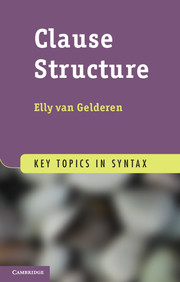1 - Introduction
Published online by Cambridge University Press: 05 June 2013
Summary
Much has been written on what constitutes a clause cross-linguistically. In English, main clauses minimally contain a finite verb and a subject, whereas subordinate clauses may lack an independent subject or a finite verb. Before discussing the descriptive characteristics of the clause in Chapter 2, I first present a brief overview of Generative Grammar and some of the main issues of the moment: Universal Grammar, Principles and Parameters, and the status of phrase structure rules.
Chomsky (1965 and later) emphasizes descriptive and explanatory adequacy. By that, he means that our models need to describe what the grammar of a language is and how children learn it. In recent years, he has emphasized a third question, namely why the grammar is the way it is. This question is also known as going “beyond explanatory adequacy” (Chomsky 2004), and I will discuss it in Section 1.1 of this chapter, though it is not the focus of this book.
The chapter is organized as follows. In Section 1.1, the focus is on Universal Grammar, the early instantiations of phrase structure rules, and the Principles and Parameters approach that is still the basis for Minimalism. In Section 1.2, I sketch the changes from phrase structure rules through X-bar theory to bare phrase structure and to the current problematization of projection. I also outline the changes from transformations to Move-alpha to Agree and features. In Section 1.3, I introduce Cartography and, in Section 1.4, we look at word order issues. In Section 1.5,we return to what might be feature parameters of the clause.
- Type
- Chapter
- Information
- Clause Structure , pp. 1 - 38Publisher: Cambridge University PressPrint publication year: 2013
- 1
- Cited by

